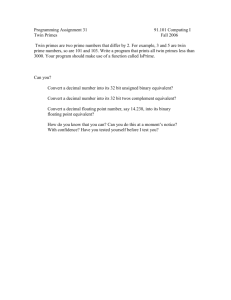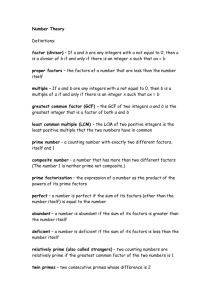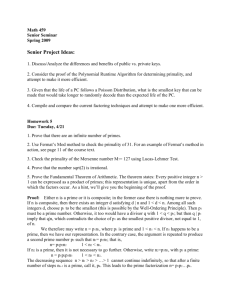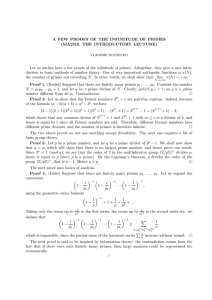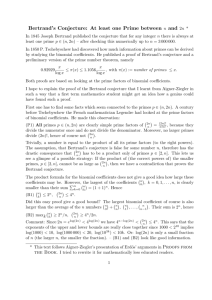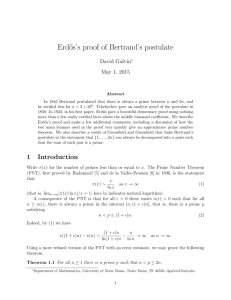The Prime Number Theorem
advertisement
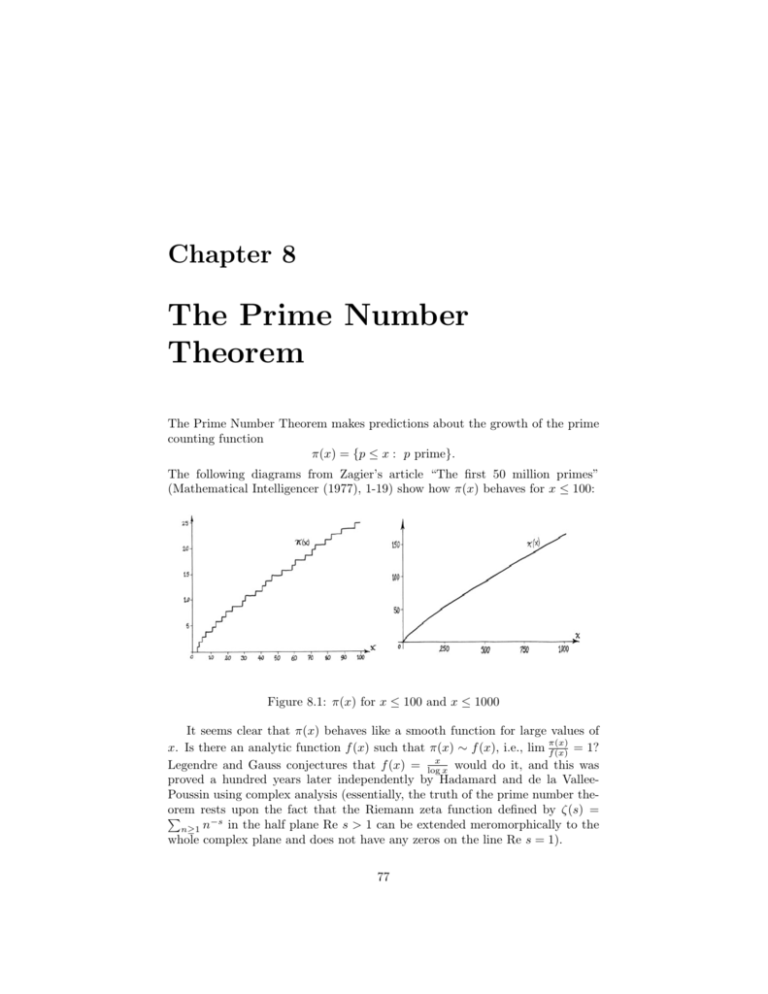
Chapter 8
The Prime Number
Theorem
The Prime Number Theorem makes predictions about the growth of the prime
counting function
π(x) = {p ≤ x : p prime}.
The following diagrams from Zagier’s article “The first 50 million primes”
(Mathematical Intelligencer (1977), 1-19) show how π(x) behaves for x ≤ 100:
Figure 8.1: π(x) for x ≤ 100 and x ≤ 1000
It seems clear that π(x) behaves like a smooth function for large values of
x. Is there an analytic function f (x) such that π(x) ∼ f (x), i.e., lim π(x)
f (x) = 1?
x
Legendre and Gauss conjectures that f (x) = log x would do it, and this was
proved a hundred years later independently by Hadamard and de la ValleePoussin using complex analysis (essentially, the truth of the prime number theorem rests upon the fact that the Riemann zeta function defined by ζ(s) =
P
−s
in the half plane Re s > 1 can be extended meromorphically to the
n≥1 n
whole complex plane and does not have any zeros on the line Re s = 1).
77
A first step in the direction of a proof of the prime number theorem was
done by Chebyshev, who proved with his bare hands that there exist constants
c1 , c2 > 0 with
x
x
c1
< π(x) < c2
.
log x
log x
The closer the constants cj are to 1, the more technical the proof becomes. Here
we will show that c1 = log2 2 and c2 = 6 log 2 do work.
Chebyshev’s
proof uses elementary properties of the binomial coefficients
(2m)!
2m
.
Here
are some of them:
=
m!m!
m
P2n
2n
2n
2n
1. 22n ≤ 2n
= m=0 2m
n ≤ 2 : this comes from (1 + 1)
m .
2. 2n
n is not divisible by any primes p > 2n.
3. 2n
n is divisible by all primes n < p ≤ 2n.
8.1
The Upper Bound
Properties (2) and (1) of the middle binomial coefficient imply that
Y
2n
π(2n)−π(n)
≤ 22n .
n
≤
p≤
n
n<p≤2n
Taking the log gives π(2n) − π(n) ≤ 2 log 2 logn n . Using induction we now easily
see that
2k
π(2k ) ≤ 3 · .
k
In fact, this is checked directly for k ≤ 5; for k > 5 we find
π(2k+1 ) ≤ π(2k ) +
3 · 2k
2 · 2k
5 · 2k
3 · 2k+1
2k+1
≤
+
=
≤
.
k
k
k
k
k+1
Now we exploit the fact that f (x) =
Thus if 4 ≤ 2k < x ≤ 2k+1 , then
π(x) ≤ π(2k+1 ) ≤ 6
x
log x
is monotonely increasing for x ≥ e.
2k
2k
x
≤ 6 log 2
≤ 6 log 2
.
k
k+1
log 2
log x
Since π(x) ≤ 6 log 2 logx x for x ≤ 4, the proof is now complete.
8.2
The Lower Bound
Here we will have to work slightly harder. First we prove
Lemma 8.1. Let vp (n) denote the exponent of the maximal power of p dividing
n. Then
Xj n k
vp (n!) =
.
pm
m≥1
78
Proof. Among the numbers 1, 2, . . . , n, exactly b np c are multiples of p and thus
contribute 1 to the exponent; moreover, exactly b pn2 c are multiples of p2 and
contribute another 1 to the exponent . . .
Now put N = 2n
n . By the lemma above we have
vp (N ) =
j n k
X j 2n k
−
2
.
pm
pm
m≥1
Now we use
Lemma 8.2. For all x ∈ R we have b2xc − 2bxc ∈ {0, 1}.
Proof. Write x = bxc + {x}. If the fractional part {x} < 12 , then 2x = 2bxc +
{2x}, hence b2xc − 2bxc = 0. If {x} ≥ 21 , then we get b2xc − 2bxc = 1.
It is also clear that if m >
log 2n
log p ,
n
then b p2n
m c − 2b pm c = 0. Thus we find
2n
vp (N ) ≤ b log
log p c, and now
2n
n
X j log 2n k
≤
log p
log p
p≤2n
X
≤
log 2n
2n log 2 − log 2n ≤ log
2n
22n
≤
2n
n
Y
because N =
pvp (N )
because
because dxe ≤ x
p≤2n
= π(2n) log 2n
This yields the lower bound
π(2n) ≥ log 2
2n
− 1.
log 2n
We claim that this implies
π(x) ≥
log 2 x
2 log x
for all x ≥ 2. This inequality can be checked directly for x ≤ 16, hence it is
sufficient to prove it for x > 16. Pick an integer n with 16 ≤ 2n < x ≤ 2n + 2.
Then
2n
n+1
n−1
7
1
−
=
≥
≥
,
log 2n log 2n
log 2n
4 log 2
log 2
hence
π(x) ≥ π(2n) ≥ log 2
2n
(n + 1) log 2
log 2 x
−1≥
≥
.
log 2n
log(2n + 2)
2 log x
79
8.3
Bertrand’s Postulate
By improving the constants c1 and c2 above it is clear that Bertrand’s conjecture
that π(2n) − π(n) > 0 for all integers n must follow: there is at least one
prime between n and 2n for all n ∈ N. In fact a simple calculation shows
that Bertrand’s conjecture follows as soon as we can find bounds that satisfy
2c1 > c2 .
Q
Here is a direct proof. Put Θ(x) = p≤x p.
Proposition 8.3. We have Θ(x) ≤ 4x .
Proof. It is clearly
to prove this for integers x ≥ 4. Observe that
sufficient
2m+1
2m+1
2m
m
=
<
2
=
4
.
This gives
m
m+1
Y
2m + 1
p|
< 4m .
m
m+2≤p≤2m+1
Now we prove the claim by induction; assume it is true for all n < k. If k is
even, then Θ(k) = Θ(k − 1) < 4k−1 < 4k by induction assumption and the fact
that k is not prime. Assume therefore that k = 2m + 1. Then
Y
Θ(k) = Θ(m + 1)
p < 4m+1 · 4m = 4k .
m+2≤p≤2m+1
We have already seen that N = 2n
n is divisible by all primes p with n <
p ≤ 2n (if there are any). Now we claim that the primes p with 32 n < p ≤ n do
2n
not divide N . In fact we have 2n < 3p ≤ p2 , hence 2 ≤ 2n
p < 3, hence d p e = 2
n
and d p e = 1, and this implies that vp (N ) = 2 − 2 = 0.
Now we prove Bertrand’s postulate by contradiction. Assume there is an
integer n such that the interval (n, 2n] does
not contain any prime. By the
discussion above this implies that N = 2n
is
not
divisible by any prime p > 23 n.
n
2
vp
Now consider primes
√ p | N with vp (N ) > 1. They satisfy p ≤ p ≤ 2n, hence
we must have
√ p ≤ 2n for such primes. The number of such primes is clearly
bounded by 2n. Now we find
2n √
√
Y
Y
2n
22n
≤
≤
pv p ·
p ≤ (2n) 2n · Θ
≤ (2n) 2n 24n/3 .
2n
n
3
v >1
v =1
p
p
Taking the log we get
2n log 2 ≤ 3(1 +
√
2n ) log 2n.
Since logx x is monotonically increasing for x > 3, this inequality must be false
for all sufficiently large values of n. In fact, it is false for n ≥ 512. For n < 512,
Bertrand’s postulate is proved by looking at the sequence of primes 7, 13, 23,
43, 83, 163, 317, 631.
80






